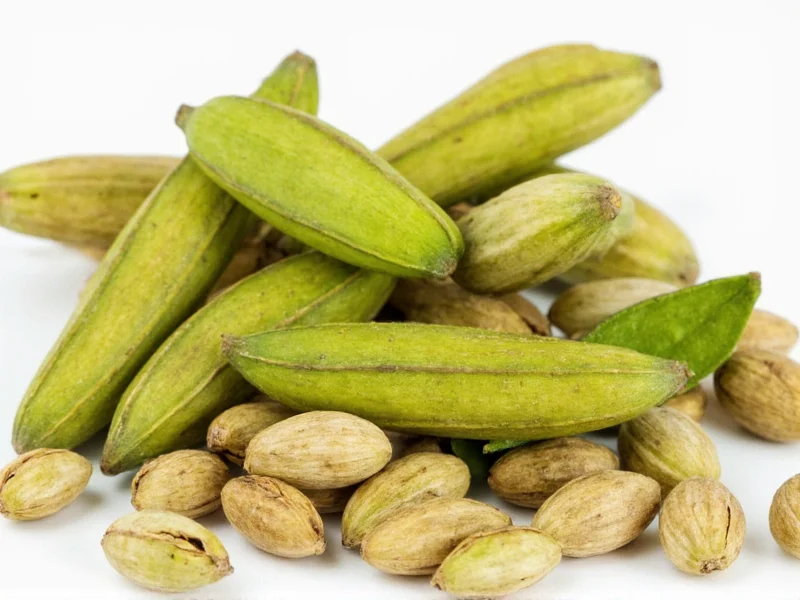Understanding the distinction between cardamom pods and seeds is essential for achieving authentic flavors in your cooking. Cardamom, one of the world's most ancient and valuable spices, comes in two primary forms that many home cooks mistakenly treat as interchangeable. This comprehensive guide clarifies the differences, proper usage techniques, and culinary applications to help you maximize this aromatic spice's potential.
Cardamom Anatomy: Pods and Seeds Explained
Cardamom pods are the triangular-shaped capsules that grow on Elettaria cardamomum plants. Each pod contains 8-16 tiny black seeds. The green variety (most common in Western cooking) has a delicate, citrusy flavor, while black cardamom offers a smokier, more intense profile. The pods themselves are fibrous and slightly bitter, while the seeds contain the concentrated aromatic compounds that give cardamom its distinctive flavor.
Physical Characteristics Comparison
| Characteristic | Cardamom Pods | Cardamom Seeds |
|---|---|---|
| Appearance | Green or black triangular capsules (1-2 cm long) | Small black or dark brown spherical seeds |
| Flavor Profile | Milder, with herbal notes from the pod | Intense, concentrated citrus and floral notes |
| Shelf Life | 6-9 months when stored properly | 3-6 months after extraction |
| Common Culinary Use | Infusing liquids, whole spice blends | Ground spice, direct addition to dishes |
When to Use Pods vs. Seeds
Chefs choose between cardamom pods and seeds based on the desired flavor release and texture. Whole pods work best for slow-cooked dishes like biryanis, stews, and rice puddings where they can infuse flavor over time without becoming bitter. Indian and Middle Eastern cuisines often use whole green cardamom pods in rice dishes and meat preparations. Scandinavian baking typically calls for ground seeds in pastries like kardemummabullar.
Extracting seeds from cardamom pods requires minimal effort but makes a significant difference in flavor intensity. To remove seeds, gently crush the pod with the flat side of a knife, then shake out the tiny black seeds. For optimal flavor in baking or spice blends, toast the seeds lightly before grinding. This technique for using cardamom seeds in baking releases their essential oils and creates a more complex flavor profile than pre-ground powder.
Storage Best Practices
Proper storage preserves cardamom's volatile aromatic compounds. Keep whole pods in an airtight container away from light and heat. The intact pods maintain freshness significantly longer than extracted seeds. Cardamom pod storage tips include checking for flexibility - fresh pods should bend slightly without cracking. Once you've extracted cardamom seeds from pods, use them within a few weeks for maximum flavor impact, as their essential oils dissipate quickly.
Substitution Guidelines
Understanding cardamom seed to powder conversion helps when adapting recipes. One cardamom pod typically contains about 1/8 teaspoon of seeds. When substituting ground cardamom for seeds, use 1/4 teaspoon of powder for every 6-8 seeds. However, avoid substituting whole pods for seeds in baking applications - the fibrous texture creates an unpleasant mouthfeel. For the difference between cardamom pods and seeds in baking applications, always extract the seeds for proper texture.
Professional Preparation Techniques
Mastering how to use cardamom pods in cooking elevates your dishes significantly. For rice dishes, lightly crush pods before adding to allow flavor release while keeping them intact for easy removal. In Scandinavian baking, chefs often split pods lengthwise and scrape out the seeds directly into batter. When making chai, whole pods simmer with other spices to create a more rounded flavor than ground cardamom alone. For Middle Eastern coffee, lightly crush pods to release aroma without making the coffee gritty.
Avoiding Common Cardamom Mistakes
Many home cooks make critical errors with cardamom that diminish its flavor. Never use the entire pod in smooth dishes like custards or cake batters - the fibrous material creates unpleasant texture. Don't grind whole pods with seeds inside, as the pod material makes an inferior powder. Avoid purchasing pre-ground cardamom when possible, as it loses potency within weeks. For optimal results in how to extract seeds from cardamom pods, use a mortar and pestle for small quantities rather than electric grinders which can overheat the spice.











 浙公网安备
33010002000092号
浙公网安备
33010002000092号 浙B2-20120091-4
浙B2-20120091-4